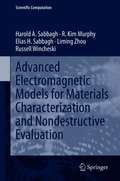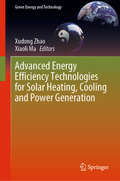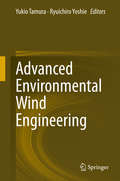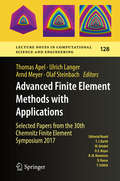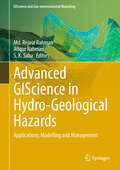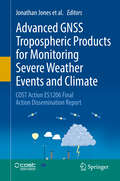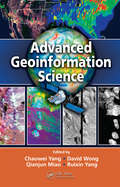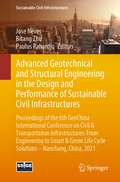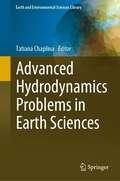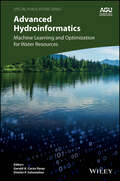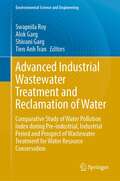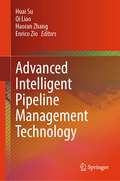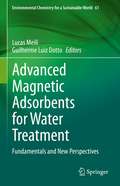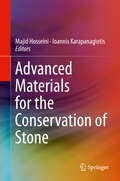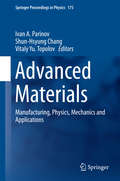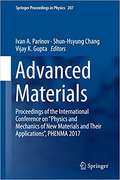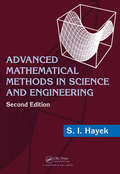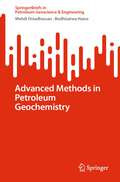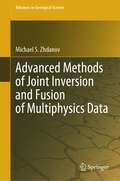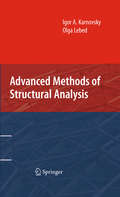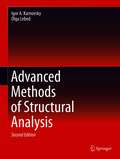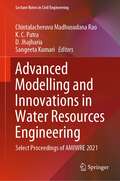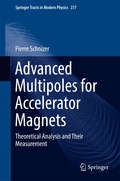- Table View
- List View
Advanced Digital Signal Processing of Seismic Data
by Wail A. MousaSeismic data must be interpreted using digital signal processing techniques in order to create accurate representations of petroleum reservoirs and the interior structure of the Earth. This book provides an advanced overview of digital signal processing (DSP) and its applications to exploration seismology using real-world examples. The book begins by introducing seismic theory, describing how to identify seismic events in terms of signals and noise, and how to convert seismic data into the language of DSP. Deterministic DSP is then covered, together with non-conventional sampling techniques. The final part covers statistical seismic signal processing via Wiener optimum filtering, deconvolution, linear-prediction filtering and seismic wavelet processing. With over sixty end-of-chapter exercises, seismic data sets and data processing MATLAB codes included, this is an ideal resource for electrical engineering students unfamiliar with seismic data, and for Earth Scientists and petroleum professionals interested in DSP techniques.
Advanced Electromagnetic Models for Materials Characterization and Nondestructive Evaluation (Scientific Computation)
by Elias H. Sabbagh Harold A Sabbagh R. Kim Murphy Liming Zhou Russell WincheskiThis book expands on the subject matter of ’Computational Electromagnetics and Model-Based Inversion: A Modern Paradigm for Eddy-Current Nondestructive Evaluation.’ It includes (a) voxel-based inversion methods, which are generalizations of model-based algorithms; (b) a complete electromagnetic model of advanced composites (and other novel exotic materials), stressing the highly anisotropic nature of these materials, as well as giving a number of applications to nondestructive evaluation; and (c) an up-to-date discussion of stochastic integral equations and propagation-of-uncertainty models in nondestructive evaluation. As such, the book combines research started twenty-five years ago in advanced composites and voxel-based algorithms, but published in scattered journal articles, as well as recent research in stochastic integral equations. All of these areas are of considerable interest to the aerospace, nuclear power, civil infrastructure, materials characterization and biomedical industries. The book covers the topic of computational electromagnetics in eddy-current nondestructive evaluation (NDE) by emphasizing three distinct topics: (a) fundamental mathematical principles of volume-integral equations as a subset of computational electromagnetics, (b) mathematical algorithms applied to signal-processing and inverse scattering problems, and (c) applications of these two topics to problems in which real and model data are used. It is therefore more than an academic exercise and is valuable to users of eddy-current NDE technology in industries as varied as nuclear power, aerospace, materials characterization and biomedical imaging.
Advanced Energy Efficiency Technologies for Solar Heating, Cooling and Power Generation (Green Energy and Technology)
by Xudong Zhao Xiaoli MaThis book, based on the research experience and outcomes of a group of international contributors, addresses a range of advanced energy efficiency technologies and their applications in solar heating, cooling and power generation, while also providing solutions for tackling recurring low efficiency problems in today’s systems. It highlights the latest technologies and methods, which can significantly improve the performance of solar systems, enabling readers to design, construct and apply high-performance solar systems in or for their own projects. The contributors provide a systematic introduction to state-of-the-art energy efficiency technologies that demonstrates how to implement innovative solar systems. These technologies include: • heat pipes and loop heat pipes; • phase change materials (PCMs) and PCM slurries; • micro-channel panels; • desiccant/adsorption cycling; • ejector cooling and heat pumps; and • solar concentration and thermoelectric units. The book shows how innovative solar systems applicable to rural and urban buildings can be analysed and demonstrates the successful implementation of these advanced technologies. It delivers the design principles and associated energy performance assessment methods for a range of selected solar heating, cooling and power generation projects. This book offers a valuable source of information for final-year undergraduate students, as well as graduate students and academic lecturers, as it promotes the widespread deployment of advanced solar heating, cooling and power generation technologies applicable for buildings across the globe. The book is also a good point of reference for design engineers and energy consultants who wish to extend their knowledge of advanced technologies used to achieve energy efficiency.
Advanced Environmental Wind Engineering
by Yukio Tamura Ryuichiro YoshieThis book is highly suitable for advanced courses asit introduces state-of-the-art information and the latest research results ondiverse problems in the environmental wind engineering field. The topics includeindoor natural ventilation, pedestrian wind environment, pollutant dispersion,urban heat island phenomena, urban ventilation, indoor/outdoor thermal comfort,and experimental/numerical techniques to analyze those issues. Winds have a great influence on the outdoorenvironment, especially in urban areas. Problems that they cause can beattributed to either strong wind or weak wind issues. Strong winds aroundhigh-rise buildings can bring about unpleasant, and in some cases dangerous,situations for people in the outdoor environment. On the other hand, weak windconditions can also cause problems such as air pollution and heat islandphenomena in urban areas. Winds enhance urban ventilation and reduce thoseproblems. They also enhance natural ventilation in buildings, which can reducethe energy consumption of mechanical ventilation fans and air conditioners forcooling. Moderate winds improve human thermal comfort in both indoor andoutdoor environments in summer. Environmental wind engineering associated withwind tunnel experiments and numerical analysis can contribute to solutions tothese issues.
Advanced Finite Element Methods with Applications: Selected Papers from the 30th Chemnitz Finite Element Symposium 2017 (Lecture Notes in Computational Science and Engineering #128)
by Ulrich Langer Thomas Apel Arnd Meyer Olaf SteinbachFinite element methods are the most popular methods for solving partial differential equations numerically, and despite having a history of more than 50 years, there is still active research on their analysis, application and extension. This book features overview papers and original research articles from participants of the 30th Chemnitz Finite Element Symposium, which itself has a 40-year history. Covering topics including numerical methods for equations with fractional partial derivatives; isogeometric analysis and other novel discretization methods, like space-time finite elements and boundary elements; analysis of a posteriori error estimates and adaptive methods; enhancement of efficient solvers of the resulting systems of equations, discretization methods for partial differential equations on surfaces; and methods adapted to applications in solid and fluid mechanics, it offers readers insights into the latest results.
Advanced GIScience in Hydro-Geological Hazards: Applications, Modelling and Management (GIScience and Geo-environmental Modelling)
by Atiqur Rahman Md. Rejaur Rahman S. K. SahaIn recent decades, natural hazards have increasingly threatened lives, livelihoods, and economies, with annual losses totalling billions of dollars globally. According to the Insurance Information Institute (III) and the Zebra, USA, natural disaster losses reached $74.4 billion in 2020, and an average of 6,800 natural disasters occur each year, claiming around 1.35 million lives. Hydrological and geological hazards, in particular, have significant societal and environmental impacts, making them critical areas of research. Understanding and mitigating these hazards is vital for developing legal mechanisms related to environmental restoration, societal improvements, and sustainable development. Modern technologies and earth observation data play a crucial role in disaster monitoring, prediction, modelling, and management. Recent advancements in geoinformation science have introduced multi-source data for natural hazards research. In addition, cutting-edge methods such as machine learning, deep learning, and big data science offer powerful tools for in-depth studies of natural hazards through remote sensing and geoinformatics. This book, Advanced GIScience in Hydro-Geological Hazards, presents up-to-date contributions on applying advanced GIScience to research various hydro-geological hazards, including floods, landslides, tropical cyclones, soil erosion, coastal erosion, riverbank erosion, coastal area vulnerability, drought, wetlands shrinking etc. It also explores multi-hazard studies using SAR, GNSS, and other innovative methods. The chapters focus on integrating artificial intelligence, machine learning techniques, and remote sensing to enhance preparedness, response, and resilience against these hazards. Targeting a broad audience of academics, scientists, students, environmentalists, government agencies, disaster planners, and GIS experts, this book aims to showcase the latest advancements in GIScience for assessing and managing hydro-geological hazards. It offers strategies for disaster risk reduction and capacity building, providing readers with the knowledge needed to address pressing environmental challenges.
Advanced GNSS Tropospheric Products for Monitoring Severe Weather Events and Climate: COST Action ES1206 Final Action Dissemination Report
by Jonathan Jones Guergana Guerova Jan Douša Galina Dick Siebren De Haan Eric Pottiaux Olivier Bock Rosa Pacione Roeland Van MalderenThe book (COST Action Final report) summarises the proceedings from COST Action ES1206. COST Action ES1206, Advanced GNSS Tropospheric Products for Severe Weather Events and Climate (GNSS4SWEC), was a 4-year project, running from 2013 to 2017, which coordinated new and improved capabilities from concurrent developments in GNSS, meteorological and climate communities. For the first time, the synergy of multi-GNSS constellations was used to develop new, more advanced tropospheric products, exploiting the full potential of multi-GNSS on a wide range of temporal and spatial scales - from real-time products monitoring and forecasting severe weather, to the highest quality post-processed products suitable for climate research. The Action also promoted the use of meteorological data as an input to real-time GNSS positioning, navigation, and timing services and has stimulated knowledge and data transfer throughout Europe and beyond.
Advanced Geodynamics: The Fourier Transform Method
by David T. SandwellDavid Sandwell developed this advanced textbook over a period of nearly 30 years for his graduate course at Scripps Institution of Oceanography. The book augments the classic textbook Geodynamics by Don Turcotte and Jerry Schubert, presenting more complex and foundational mathematical methods and approaches to geodynamics. The main new tool developed in the book is the multi-dimensional Fourier transform for solving linear partial differential equations. The book comprises nineteen chapters, including: the latest global data sets; quantitative plate tectonics; plate driving forces associated with lithospheric heat transfer and subduction; the physics of the earthquake cycle; postglacial rebound; and six chapters on gravity field development and interpretation. Each chapter has a set of student exercises that make use of the higher-level mathematical and numerical methods developed in the book. Solutions to the exercises are available online for course instructors, on request.
Advanced Geoinformation Science
by David Wong Chaowei Yang Ruixin Yang Qianjun MiaoMany of the challenges of the next century will have physical dimensions, such as tsunamis, hurricanes, and climate change as well as human dimensions such as economic crises, epidemics, and emergency responses. With pioneering editors and expert contributors, Advanced Geoinformation Science explores how certain technical aspects of geoinformation
Advanced Geotechnical and Structural Engineering in the Design and Performance of Sustainable Civil Infrastructures: Proceedings of the 6th GeoChina International Conference on Civil & Transportation Infrastructures: From Engineering to Smart & Green Life Cycle Solutions -- Nanchang, China, 2021 (Sustainable Civil Infrastructures)
by Jose Neves Bitang Zhu Paulus RahardjoThis book covers different geotechnical and structural engineering topics applied to buildings, power grid infrastructures, hydroelectric projects, bridges, and transport infrastructures. The book contains research data useful for researchers and practitioners to support the sustainable design, building, operation, and maintenance of civil infrastructures. The papers included in this book were selected from the 6th GeoChina International Conference on Civil & Transportation Infrastructures: From Engineering to Smart & Green Life Cycle Solutions.
Advanced Hydrodynamics Problems in Earth Sciences (Earth and Environmental Sciences Library)
by Tatiana ChaplinaThis book explains the dynamics of natural systems – the geosphere, hydrosphere and atmosphere – and their interactions, along with the human contribution to naturally occurring processes, which is one of the most urgent and practically important scientific problems of our age. The widespread use of sophisticated, tremendously powerful supercomputers now allows us to model complex phenomena that were previously inaccessible for analysis. Further, the introduction and advancement of a new generation of geophysical instruments – remote observing systems installed on ships, aircraft and satellites – make it possible to gather huge amounts of objective, representative data. The articles presented here offer valuable insights into the laboratory modelling of geo-environments and testing of newly developed physical and mathematical models.
Advanced Hydroinformatics: Machine Learning and Optimization for Water Resources (Special Publications #78)
by Dimitri P. Solomatine Gerald A. Corzo PerezAdvanced Hydroinformatics Advanced Hydroinformatics Machine Learning and Optimization for Water Resources The rapid development of machine learning brings new possibilities for hydroinformatics research and practice with its ability to handle big data sets, identify patterns and anomalies in data, and provide more accurate forecasts. Advanced Hydroinformatics: Machine Learning and Optimization for Water Resources presents both original research and practical examples that demonstrate how machine learning can advance data analytics, accuracy of modeling and forecasting, and knowledge discovery for better water management. Volume Highlights Include: Overview of the application of artificial intelligence and machine learning techniques in hydroinformatics Advances in modeling hydrological systems Different data analysis methods and models for forecasting water resources New areas of knowledge discovery and optimization based on using machine learning techniques Case studies from North America, South America, the Caribbean, Europe, and Asia The American Geophysical Union promotes discovery in Earth and space science for the benefit of humanity. Its publications disseminate scientific knowledge and provide resources for researchers, students, and professionals.
Advanced Industrial Wastewater Treatment and Reclamation of Water: Comparative Study of Water Pollution Index during Pre-industrial, Industrial Period and Prospect of Wastewater Treatment for Water Resource Conservation (Environmental Science and Engineering)
by Swapnila Roy Tien Anh Tran Alok Garg Shivani GargThis book focuses on industrial wastes that either join the streams or other natural water bodies directly, or are emptied into the municipal sewers, and their characteristics vary widely depending on the source of production and the raw material used by the industry, even during pre-industrial, industrial period and prospect of wastewater treatment for water resource conservation. The treatment of industrial wastewater can be done in part or as a whole either by the biological or chemical processes. Advanced treatment methods like membrane separation, ultra-filtration techniques and adsorption are elaborated. It would emphasize and facilitate a greater understanding of all existing available research, i.e., theoretical, methodological, well-established and validated empirical work, associated with the environment and climate change aspects.
Advanced Intelligent Pipeline Management Technology
by Enrico Zio Qi Liao Huai Su Haoran ZhangThis book summarizes the advanced intelligent pipeline management technologies. The text discusses the main challenges of how to define and reinvent data-driven intelligent pipeline systems by studying scheduling-operation- safety management systems. Additionally, within an all-around intelligent pipeline system technology development framework, this book characterizes the scientific problems of intelligent pipeline system services among different processes, such as scheduling, demand-side management, operation condition monitoring, safety analysis, fault detection, etc. This book also introduces the existing positive and successful intelligent pipeline system projects that can be identified in the studied domain, and how can they be best applied for practical success. The text is supported by informative illustrations and case studies so that practitioners can use the book as a toolbox to improve understanding in applying the novel technologies into intelligent pipeline system management and development.
Advanced Magnetic Adsorbents for Water Treatment: Fundamentals and New Perspectives (Environmental Chemistry for a Sustainable World #61)
by Lucas Meili Guilherme Luiz DottoThis book compiles 15 chapters about the synthesis, characterizations, and application of many kinds of magnetic adsorbents for water treatment. It is devoted to the scientific community that works with adsorption technologies for water treatment and remediation. Specifically, for professors and Ph.D. students. It is expected that this book serves as an interesting background for researchers in the field of magnetic adsorbents for water treatment.
Advanced Materials for the Conservation of Stone
by Majid Hosseini Ioannis KarapanagiotisThis book identifies novel advanced materials that can be utilized as protective agents for the preservation of stone. The innovative solutions to stone conservation presented here result in increased sustainability, reduced environmental impact, and increased social and economic benefits. It provides an overview of recent trends and progress in advanced materials applied to stone protection. It also explores the scientific principles behind these advanced materials and discusses their applications to diff erent types of stone preservation efforts. Essential information as well as knowledge on the availability and applicability of advanced nanostructured materials is also provided, with focus placed on the practical aspects of stone protection. Th e book highlights an interdisciplinary eff ort regarding novel applications of nanostructured materials in the advancement of stone protection. It provides insight towards forthcoming developments in the fi eld. Advanced nanostructured materials are designed and developed with the aim of being chemically, physically, and mechanically compatible with stone. Advanced materials for stone conservation that are characterized by several functional properties are considered in this book. These include the physico-chemical, protective, and morphological properties, eco-toxicity, and mechanisms of degradation. The authors present a thorough overview of cutting-edge discoveries, detailed information on recent technological developments, breakthroughs in novel nanomaterials, utilization strategies for applications in cultural heritage, and the current status and future outlook of the topic to address a wide range of scientific communities.
Advanced Materials: Manufacturing, Physics, Mechanics and Applications (Springer Proceedings in Physics #175)
by Vitaly Yu. Topolov Shun-Hsyung Chang Ivan A. ParinovAdvanced materials are the basis of modern science and technology. This proceedings volume presents a broad spectrum of studies of novel materials covering their processing techniques, physics, mechanics, and applications. The book is concentrated on nanostructures, ferroelectric crystals, materials and composites, materials for solar cells and also polymeric composites. Nanotechnology approaches, modern piezoelectric techniques and also latest achievements in materials science, condensed matter physics, mechanics of deformable solids and numerical methods are presented. Great attention is devoted to novel devices with high accuracy, longevity and extended possibilities to work in wide temperature and pressure ranges, aggressive media etc. The characteristics of materials and composites with improved properties opening new possibilities of various physical processes, in particular transmission and receipt of signals under water, are described.
Advanced Materials: Proceedings Of The International Conference On Physics And Mechanics Of New Materials And Their Applications , PHENMA 2017 (Springer Proceedings In Physics #207)
by Shun-Hsyung Chang Ivan A. Parinov Vijay K. GuptaProvides a consistent and original presentation of fabrication techniques, physics, mechanics, and applications of advanced materials and composites.<p><p> Helps readers to better understand modern R&D requirements for prospective materials and composites.<p> Features original theoretical, experimental and modeling results on novel materials and devices.<p> This book presents selected peer-reviewed contributions from the 2017 International Conference on “Physics and Mechanics of New Materials and Their Applications”, PHENMA 2017 (Jabalpur, India, 14–16 October, 2017), which is devoted to processing techniques, physics, mechanics, and applications of advanced materials. The book focuses on a wide spectrum of nanostructures, ferroelectric crystals, materials and composites as well as promising materials with special properties. It presents nanotechnology approaches, modern environmentally friendly piezoelectric and ferromagnetic techniques and physical and mechanical studies of the structural and physical–mechanical properties of materials. Various original mathematical and numerical methods are applied to the solution of different technological, mechanical and physical problems that are interesting from theoretical, modeling and experimental points of view. Further, the book highlights novel devices with high accuracy, longevity and extended capabilities to operate under wide temperature and pressure ranges and aggressive media, which show improved characteristics, thanks to the developed materials and composites, opening new possibilities for different physico-mechanical processes and phenomena
Advanced Mathematical Methods in Science and Engineering
by S.I. HayekClassroom-tested, Advanced Mathematical Methods in Science and Engineering, Second Edition presents methods of applied mathematics that are particularly suited to address physical problems in science and engineering. Numerous examples illustrate the various methods of solution and answers to the end-of-chapter problems are included at the back of t
Advanced Methods in Petroleum Geochemistry (SpringerBriefs in Petroleum Geoscience & Engineering)
by Mehdi Ostadhassan Bodhisatwa HazraThis brief presents recent developments and new methodologies in the area of petroleum geochemistry, including innovative unconventional analytical methods such as Raman, NMR and XPS spectroscopy that are based on advanced analytical chemistry and recently developed instrumentation. It discusses delineating mechanisms for petroleum generation, expulsion, migration and accumulation in reservoirs from the source rock. This brief provides data, illustrations and detailed explanation of each method discussed, as well as data collection, interpretation of the results and intercorrelated characteristics of different case studies from a variety of samples. Geologists, engineers, and graduate students interested in the petroleum industry will all find the book valuable.
Advanced Methods of Joint Inversion and Fusion of Multiphysics Data (Advances in Geological Science)
by Michael S. ZhdanovDifferent physical or geophysical methods provide information about distinctive physical properties of the objects, e.g., rock formations and mineralization. In many cases, this information is mutually complementary, which makes it natural for consideration in a joint inversion of the multiphysics data. Inversion of the observed data for a particular experiment is subject to considerable uncertainty and ambiguity. One productive approach to reducing uncertainty is to invert several types of data jointly. Nonuniqueness can also be reduced by incorporating additional information derived from available a priori knowledge about the target to reduce the search space for the solution. This additional information can be incorporated in the form of a joint inversion of multiphysics data.Generally established joint inversion methods, however, are inadequate for incorporating typical physical or geological complexity. For example, analytic, empirical, or statistical correlations between different physical properties may exist for only part of the model, and their specific form may be unknown. Features or structures that are present in the data of one physical method may not be present in the data generated by another physical method or may not be equally resolvable.This book presents and illustrates several advanced, new approaches to joint inversion and data fusion, which do not require a priori knowledge of specific empirical or statistical relationships between the different model parameters or their attributes. These approaches include the following novel methods, among others: 1) the Gramian method, which enforces the correlation between different parameters; 2) joint total variation functional or joint focusing stabilizers, e.g., minimum support and minimum gradient support constraints; 3) data fusion employing a joint minimum entropy stabilizer, which yields the simplest multiphysics solution that fits the multi-modal data. In addition, the book describes the principles of using artificial intelligence (AI) in solving multiphysics inverse problems. The book also presents in detail both the mathematical principles of these advanced approaches to joint inversion of multiphysics data and successful case histories of regional-scale and deposit-scale geophysical studies to illustrate their indicated advantages.
Advanced Methods of Structural Analysis
by Olga Lebed Igor A. KarnovskyAdvanced Methods of Structural Analysis aims to help its readers navigate through the vast field of structural analysis. The book aims to help its readers master the numerous methods used in structural analysis by focusing on the principal concepts, as well as the advantages and disadvantages of each method. The end result is a guide to mastering the many intricacies of the plethora of methods of structural analysis. The book differentiates itself from other volumes in the field by focusing on the following: * Extended analysis of beams, trusses, frames, arches and cables * Extensive application of influence lines for analysis of structures * Simple and effective procedures for computation of deflections * Introduction to plastic analysis, stability, and free vibration analysis Authors Igor A. Karnovsky and Olga Lebed have crafted a must-read book for civil and structural engineers, as well as researches and students with an interest in perfecting structural analysis. Advanced Methods of Structural Analysis also offers numerous example problems, accompanied by detailed solutions and discussion of the results.
Advanced Methods of Structural Analysis
by Olga Lebed Igor A. KarnovskyThis revised and significantly expanded edition contains a rigorous examination of key concepts, new chapters and discussions within existing chapters, and added reference materials in the appendix, while retaining its classroom-tested approach to helping readers navigate through the deep ideas, vast collection of the fundamental methods of structural analysis. The authors show how to undertake the numerous analytical methods used in structural analysis by focusing on the principal concepts, detailed procedures and results, as well as taking into account the advantages and disadvantages of each method and sphere of their effective application. The end result is a guide to mastering the many intricacies of the range of methods of structural analysis. The book differentiates itself by focusing on extended analysis of beams, plane and spatial trusses, frames, arches, cables and combined structures; extensive application of influence lines for analysis of structures; simple and effective procedures for computation of deflections; introduction to plastic analysis, stability, and free and forced vibration analysis, as well as some special topics. Ten years ago, Professor Igor A. Karnovsky and Olga Lebed crafted a must-read book. Now fully updated, expanded, and titled Advanced Methods of Structural Analysis (Strength, Stability, Vibration), the book is ideal for instructors, civil and structural engineers, as well as researches and graduate and post graduate students with an interest in perfecting structural analysis.
Advanced Modelling and Innovations in Water Resources Engineering: Select Proceedings of AMIWRE 2021 (Lecture Notes in Civil Engineering #176)
by Chintalacheruvu Madhusudana Rao K. C. Patra D. Jhajharia Sangeeta KumariThis book presents select proceedings of the national conference on Advanced Modelling and Innovations in Water Resources Engineering (AMIWRE 2021) and examines numerous advancements in the field of water resources engineering and management towards sustainable development of environment. The topics covered includes river basin planning and development, reservoir planning and management, integrated water management, reservoir sedimentation, soil erosion and sedimentation, agricultural technologies for climate change mitigation, uncertainty analysis in hydrology, water distribution networks, floods and droughts management, water quality modelling, environmental modelling, environmental impact assessment, urban water management, open channel hydraulics, hydraulic structures, groundwater hydraulics, groundwater flow and contaminant transport modelling, computational fluid dynamics, ocean engineering, HEC-RAC, SWAT, MIKE, MODFLOW models applications, numerical analysis in water resources engineering, climate change impacts on hydrology, optimization techniques in water resources, soft computing techniques and applications in water resources and remote sensing / geospatial techniques in water resources. This book will be beneficial for water sectors development mainly agricultural production, reservoir operations, improvement of water quality, flood and drought controls, designing hydraulic structures and geospatial analysis. This book will be a valuable reference for faculties, research scholars, students, design engineers, industrialists, R & D personnel and practitioners working in water resources engineering and its related fields.
Advanced Multipoles for Accelerator Magnets: Theoretical Analysis and Their Measurement (Springer Tracts in Modern Physics #277)
by Pierre SchnizerThis monograph presents research on the transversal beam dynamics of accelerators and evaluates and describes the respective magnetic field homogeneity. The widely used cylindrical circular multipoles have disadvantages for elliptical apertures or curved trajectories, and the book also introduces new types of advanced multipole magnets, detailing their application, as well as the numerical data and measurements obtained. The research presented here provides more precise descriptions of the field and better estimates of the beam dynamics. Moreover, the effects of field inhomogeneity can be estimated with higher precision than before. These findings are further elaborated to demonstrate their usefulness for real magnets and accelerator set ups, showing their advantages over cylindrical circular multipoles. The research findings are complemented with data obtained from the new superconducting beam guiding magnet models (SIS100) for the FAIR (Facility for Antiproton and Ion Research) project. Lastly, the book offers a comprehensive survey of error propagation in multipole measurements and an appendix with Mathematica scripts to calculate advanced magnetic coil designs.

